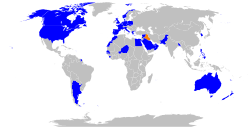
Back قوات التحالف في حرب الخليج الثانية Arabic قوات التحالف فى حرب الخليج التانيه ARZ Coalición de la guerra del Golfo Spanish 걸프 전쟁의 다국적 연합군 Korean
Coalition of the Gulf War | |
|---|---|
| 1990–1991 | |
 Coalition countries | |
| Type | Military coalition |
| Membership | Primary countries:
Other contributors:
|
| Historical era | Gulf War |
| 2–4 August 1990 | |
• Adoption of UNSC Resolution 678 | 29 November 1990 |
• Adoption of U.S. Congress Resolution Against Iraq | 14 January 1991 |
• Beginning of Gulf War air campaign | 17 January 1991 |
• Beginning of Liberation of Kuwait campaign | 24 February 1991 |
• Adoption of UNSC Resolution 686 | 2 March 1991 |
On 29 November 1990, the adoption of United Nations Security Council Resolution 678 authorized the assembly of a multinational military coalition to liberate Iraqi-occupied Kuwait by "all necessary means" if Iraq did not withdraw its forces by 15 January 1991. Iraq failed to do so, and the coalition began an aerial bombardment against targets in Iraq and Kuwait on 17 January 1991. At this time, the coalition consisted of 42 countries and was spearheaded by the United States. The central command was led by the United States, Saudi Arabia, and the United Kingdom; the marine command was led by the United States; the Joint Forces East Command was led by Egypt, Saudi Arabia, Syria, Morocco, Kuwait, Oman, the United Arab Emirates, Qatar, Bahrain, Poland, and Czechoslovakia; and the Joint Forces North Command was led by the United States, the United Kingdom, France, Canada, Italy, Australia, and Turkey.
On 23 February 1991, the aerial bombardment campaign came to an end and the coalition began a large-scale ground offensive into Iraqi-occupied Kuwait and parts of Iraq. The Iraqi military was devastated in the fighting, and Kuwait was declared completely free of Iraqi troops on 28 February 1991.

